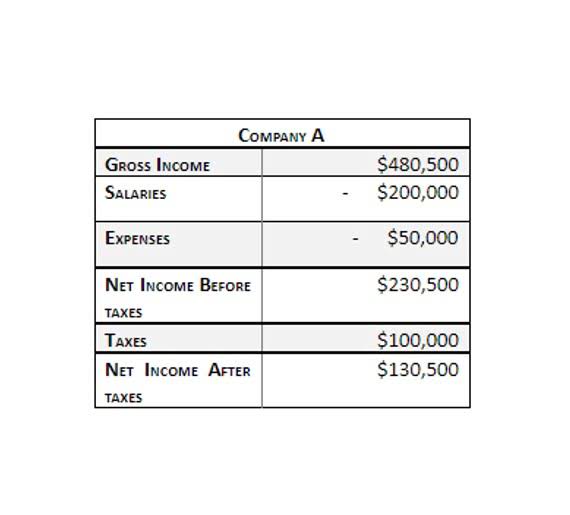Bookkeeping
Profit margin equation: How to calculate profit easily in 2024

You’ll then be able to focus on investments that fit your capacity, allowing you to assess them at a deeper level and choose the best one. Beyond knowing how much is left after deducting expenses, calculating profits provides a lot of strategic insight. At times, unique opportunities may arise, allowing you to make additional revenue. However, while they may contribute significantly to your profits for that period, they may give a wrong impression of your overall profitability. In this article, you’ll learn about the types of profit, the profit equation, and how to calculate them.
How to find net profit margin
- It’s easy to forget about indirect costs—things like rent, utilities, and salaries that aren’t tied to producing a specific product or service.
- With this information, you can improve operational efficiency and improve your pricing strategy.
- Look at your business on its own, then compare yourself to others in your industry.
- This includes things like payroll, utilities, inventory management costs, administrative costs, and shipping.
- By helping you to optimize business operations and enhance planning, you’ll be able to make the most out of the resources you have.
- Business owners use the profit formula to see how much income they generate.
It’s easy to forget about indirect costs—things like rent, utilities, and salaries that aren’t tied to producing a specific product or service. Failing to factor in these expenses when Accounting For Architects calculating profit margin will result in inflated numbers. These include the cost of labor, raw materials, debts, administrative costs, and nonoperational costs. To find your operating profit margin, divide your operating profit by your total revenue. This shows what percentage of revenue is left after covering all operating costs. Once you have your gross profit, subtract your operating expenses.
What is the profit margin equation?

This formula is useful when pricing new products or services. To get an accurate profit formula calculation, a company must include every expense as part of the total. This includes things like payroll, utilities, inventory management costs, administrative costs, and shipping. Every line item in your accounting ledger that is an expense must factor into your total expenses line item.
Age of your business

Moreover, it will also include revenues from secondary operations and investments. As a profit-making organization, your key bottom line is generating profits for shareholders. While the term profit sounds fairly straightforward, there’s a lot more to it you need to know. Such insight will help you determine ideal prices for goods and services and operate more efficiently. Learn what the profit equation is, how to calculate different types of profit, and why it is important to keep track of company profitability. Calculating your profit margin is a vital part of running a successful business, but there are some common mistakes that can throw off your numbers.
In doing so, you’ll also account for all administrative, operating, overhead, and sales expenses you incur for day-to-day business operations. The profit per unit formula is the cash flow profit from a single unit of a product or service. You need to subtract the total cost of producing one unit from the selling price. For example, if you sell a product for $50 and it costs you $30 to produce, your profit per unit would be $20.
Best practices: What to do with your profit formula

One key element for this is knowing how much you can spare for such investments and at what point. One of the biggest mistakes entrepreneurs make is assuming that lots of sales mean the business is doing well. As much as you may be making money, you may also be leaking it elsewhere.

Why understanding company profit is so important
- A crucial part of understanding company profit is to know the profit per unit.
- As such, you’ll have full visibility of your company’s financial health.
- To find your operating profit margin, divide your operating profit by your total revenue.
- Should there be any errors in your profit projections, there’s a high chance you’ll have a budget deficit.
- As such, it does not account for overhead costs, taxes, debt payments, and one-time expenses such as equipment purchases.
However, since there are different types of profit, there are various equations you can use. Using the profit formula to assess your business is something every business owner should do regularly—at least monthly. While they both have to do with the cost-revenue relationship, they measure different things. Markup is how much more you charge over the cost of a product, while profit margin is the percentage of revenue left after covering costs. Confusing the two can lead to pricing errors and affect your bottom line. If you sell a leather belt at your boot store for $25 and it costs $20 to produce, your gross profit is $5.
- In this article, you’ll learn about the types of profit, the profit equation, and how to calculate them.
- It might be lower if the company sells at lower prices to attract customers.
- Such insight will help you determine ideal prices for goods and services and operate more efficiently.
- One of the biggest mistakes entrepreneurs make is assuming that lots of sales mean the business is doing well.
- This may give you the impression that you’re highly profitable.
- Markup is how much more you charge over the cost of a product, while profit margin is the percentage of revenue left after covering costs.
What is the profit formula?
It’s a measure of how efficiently you use and convert resources into monetary value. Should there be any errors in your profit projections, there’s a high chance you’ll have a budget deficit. With this, some of the company’s projects may be derailed, leading to further revenue and profit reduction.

Maximized business growth
- When calculating profitability, businesses often look at profit margins.
- In most cases, that budget will account for revenues you roll over from the previous period and projections for the coming one.
- While you have an accurate picture for that period’s profits, you may miss some key insight.
- These include the cost of labor, raw materials, debts, administrative costs, and nonoperational costs.
- You’ll then be able to focus on investments that fit your capacity, allowing you to assess them at a deeper level and choose the best one.
- Consider your customers, your employees, and your company’s brand when making any kind of change.
Undoubtedly, profit equations can help you learn more about your company. With this information, you can improve operational efficiency and improve your pricing strategy. While the concept of profit is simple, there’s a lot more to it. First, there are different types of profit, each with a which of the following is the correct equation for profit? different formula.
